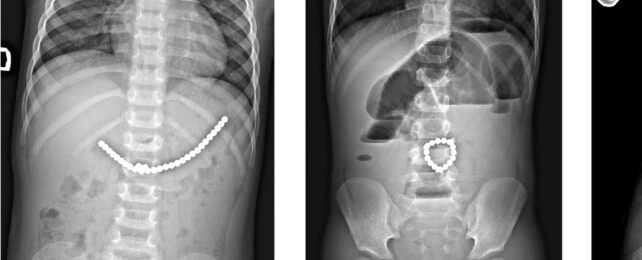Toy magnets pose a serious risk for young children, even when parents are supervising playtime.
According to new research, set to be presented by emergency medicine specialist Leah Middelberg of Nationwide Children's Hospital, the number of kids requiring emergency surgery to remove neodymium magnets is not falling, in spite of attempts to highlight the dangers.
It seems, the researchers conclude, that the only way to prevent kids eating magnets is to completely restrict access. Kids and magnets do not mix.
"High-powered, rare-earth magnetic balls or beads are often sold as fun, stress-relieving toys, but they are among the most dangerous toys when kids eat them," says pediatric surgeon Minna Wieck of UC Davis Children's Hospital.
"It doesn't matter what the child's socioeconomic or racial background is, whether the child is being watched, or if supervising adults know the magnets are dangerous – kids still manage to eat them and many of them need surgery to fix the internal damage caused by the magnets.
"The only foolproof way to make sure these injuries don't happen is to keep these types of magnets away from kids."
Rare-earth magnets have grown more popular as toys over recent decades, and they are in fact very entertaining to play with. But as their popularity has grown, so too has the number of children eating them.
Kids just put things in their mouths; for very young children, sticking things in there is a normal part of development, but kids of all ages have shown up at emergency rooms with rare-earth magnet injuries. According to the Consumer Product Safety Commission, even teens can swallow powerful magnets in the form of fake piercings.
Once ingested, the magnets can attract to each other or other objects. In one case, for instance, a 5-year-old boy swallowed a magnet, and a few days later swallowed a small metal ball.
Magnets can find each other through tissues, and when they pinch together, it can cause perforations, twisted or blocked bowels, infections, or blood poisoning. On rare occasions, it can even result in tragic death.
Luckily, the child in this case was rushed into surgery before the magnets could cause significant internal damage.
Age restrictions, warning labels, and even bans and product recalls have been issued in attempts to reduce these horrible injuries. Yet they still keep occurring.
Middelberg and her colleagues examined patient data from 25 children's hospitals in the US from 2017 to 2019. They identified 594 cases of magnet injury, not just from swallowing, but being stuck in ears or noses, in patients under the age of 21.
Interestingly, the majority – 74.3 percent – of the injuries were documented in children from higher socioeconomic backgrounds, who probably have greater access to high-powered magnet sets and parents who are more familiar with the risks. But the cases from lower socioeconomic backgrounds were more likely to be severe, requiring surgical intervention, longer hospital stays, and readmissions.
There was no difference in the time the parents took to seek care, or the number of magnets swallowed or inserted by the patients, the researchers found. Small, powerful magnets are just too tempting, apparently.
"Parents almost never think their kid will 'be so dumb as to swallow' magnets. But kids are doing so more often, despite adult supervision and even when adults know that these magnets are potentially dangerous," Wieck says.
"Since risk is proportional to access, the safest way to prevent injuries is to remove high-powered magnets from any environment where children may be present."
The research is due to be presented on 22 October at the 2023 American Academy of Pediatrics National Conference & Exhibition.
